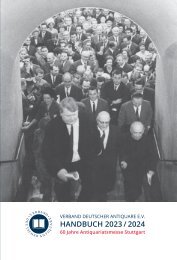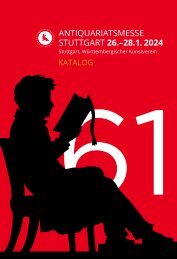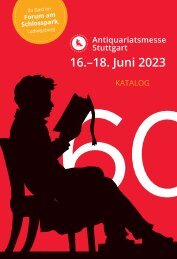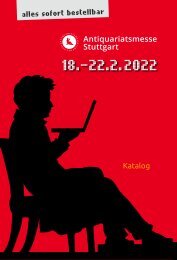Antiquariatsmesse Stuttgart 2021 - Katalog
Katalog zur Antiquariatsmesse Stuttgart 2021: Die Antiquariatsmesse Stuttgart als größtes Schaufenster für wertvolle Objekte des Antiquariats- und Graphikhandels in Deutschland findet in diesem Jahr in ungewohnter Form statt. Da eine Präsenzmesse nicht stattfinden kann, haben sich 76 Kollegen aus Deutschland, Großbritannien, Österreich, Frankreich, der Schweiz, den Niederlanden, den Vereinigten Staaten und aus Australien zusammengefunden, um einen Katalog für die Messe zu erstellen und gleichzeitig ein Angebot für eine virtuelle Messe zusammengetragen. Der Katalog wird am 7. Januar 2021 an interessierte Kunden verschickt, die virtuelle Messe öffnet ihre „digitalen Pforten“ am 29. Januar 2021 um 12.00 Uhr unter www.antiquariatsmesse-stuttgart.de
Katalog zur Antiquariatsmesse Stuttgart 2021: Die Antiquariatsmesse Stuttgart als größtes Schaufenster für wertvolle Objekte des Antiquariats- und Graphikhandels in Deutschland findet in diesem Jahr in ungewohnter Form statt. Da eine Präsenzmesse nicht stattfinden kann, haben sich 76 Kollegen aus Deutschland, Großbritannien, Österreich, Frankreich, der Schweiz, den Niederlanden, den Vereinigten Staaten und aus Australien zusammengefunden, um einen Katalog für die Messe zu erstellen und gleichzeitig ein Angebot für eine virtuelle Messe zusammengetragen.
Der Katalog wird am 7. Januar 2021 an interessierte Kunden verschickt, die virtuelle Messe öffnet ihre „digitalen Pforten“ am 29. Januar 2021 um 12.00 Uhr unter www.antiquariatsmesse-stuttgart.de
Erfolgreiche ePaper selbst erstellen
Machen Sie aus Ihren PDF Publikationen ein blätterbares Flipbook mit unserer einzigartigen Google optimierten e-Paper Software.
Antiquariaat Forum BV
Laurens Hesselink · Tuurdijk 16 · 3997 MS ’t Goy (Utrecht), Niederlande
Telefon +31 (0) 30 601 19 55
E-Mail: info@forumrarebooks.com · Internet: www.forumrarebooks.com
Atlanten & Kartographie · Früher Buchdruck · Medizingeschichte · Militärgeschichte · Naher Osten ·
Naturgeschichte · Reisen & Entdeckungen · Wissenschaften & Technologie
Very rare 15th-century gospel book for laypeople, illustrated with woodcut illustrations,
witnessing the upcoming vernacular devotion
[Gospel Book – Incunable]. [Epistolae et Evangelia.
Plenarium]. [Incipit:] Hier beghinne[n] die
epistolen, eva[n]gelien und lectien mit d[er] glosen
ind sermonen, durch dat ganze iaer. … [Cologne,
Hermann Bumgart, 20 December 1498]. Small
4to. With a woodcut on the title-page depicting
the four evangelists, 20 woodcut illustrations of
the Passion and rubrication in red throughout the
whole book. Contemporary leather over wooden
boards. € 45 000,–
15th-century gospel book in 15th-century Low German
(Lower Rhine according to the GW), translated
from the Latin edition. The so-called „Epistolae et
evangelia“ became very popular in the 15th century.
Especially in Germany this genre was booming: many
editions of this work can be traced, by different printers,
with Gunther Zainer’s edition of 1473 as being
the first. Translating liturgical texts into German was a
popular means of making the worship of the Church
more meaningful to common people and this became
quite easy and possible with the coming of the printing
press. Many „plenaria“ and editions of the „Epistolae
et evangelia“ were published, varying considerably between
different editions. – This incunable in a beautiful
contemporary binding is a very good early example of
the upcoming lay piety in the 15th century and their
preference, also due to the rising literacy of common
people, to read the (shortened) gospels in the vernacular.
Also the woodcuts illustrate this: they make
it possible to even understand the headlines of a text
visually without reading it closely. This very rare edition
by Bumgart, of which only one copy is recorded,
demonstrates this shift in the religious atmosphere of
the 15th century. – This copy was originally part of the
Monastery of Geistingen, a Redemptorist monastery
in Hennef-Geistingen, Germany. With an inscription
on the front paste-down by a later hand and a few
markings of passages with ink in the text. With a bookplate
from a library dated 1927 and a faded library
stamp on the title-page. Also included is a modern pink
piece of paper with, written in an imitated gothic script,
the text of the lacking colophon. Binding a little worn
and rubbed, a piece of the title-page and the title-page
cut out (not affecting the text, including the prologue
on the verso), lacking some pieces of leather at the
spine and boards and one of the catch plates, corners
bumped. Slightly dust-soiled and stained, bottom of
the pages sometimes a little frayed, a tear in B3 and
G2 (not affecting the text), leaf Q1 loose, lacking Q8
including the colophon and another woodcut illustration.
Otherwise still a very rare illustrated incunable
on paper of good quality in a beautiful contemporary
binding. – [205] ll., lacking the last leaf. Copinger II,
2340; GW M34266; ISTC ie00087700; USTC 740621;
cf. Bast & Gow, Continuity and change (2000), p. 126;
Hughes Oliphant Old, The reading and preaching of
the Scriptures in the worship of the Christian Church
3, the medieval Church (1999), p. 538; cf. Latin edition:
GW M3404750; ISTC ie00064691; USTC 767227; not
in BMC I, pp. 299–302 (under Hermann Bumgart);
Bod-Inc; BSB-Ink; Goff. – Siehe Abbildung.
80






